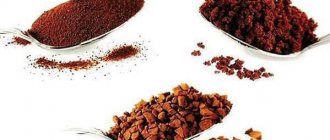The tradition of drinking coffee with milk was established by Doctor Monin in 1685. He lived in the city of Grenoble in France. The bitterness inherent in coffee irritated the doctor. Monin decided to experiment and was pleased with the result. Very quickly the recipe became popular, first in Europe, and then throughout the world.
The main component of coffee is caffeine, the effect of which on the human body is expressed in increasing mental and physical activity, therefore for billions of people this drink is an integral part of the morning ritual.
And this is not an exaggeration, because it is the leader in global sales and is second only to oil in popularity.
What is coffee with milk like?
What could be better than a cup of hot, invigorating coffee with fresh milk and in good company? Even those who do not like this aromatic drink associate it with comfort and warmth.
The recipe, which has come down to us from the seventeenth century, is a simple combination of two components. During this time, other cooking methods have appeared on its basis - using additives, characterized by a variety of tastes and enjoying popularity. The most famous and simple recipes:
- Cappuccino is a three-layer product consisting of 1/3 espresso, 1/3 liquid and 1/3 frothed milk;
- Latte – also three layers, but the coffee content is minimal, and the milk foam is thin and loose;
- Latte Macchiato – ¾ coffee and ¼ foam.
Coffee selection
Whether coffee with milk will be beneficial or harmful depends directly on the choice of ingredients included in the drink.
Natural coffee beans are considered the healthiest and tastiest type, since the best raw materials are used for its production without the addition of artificial ingredients.
The popular instant coffee does more harm than good, since it contains only 15% natural powder from poor quality beans, the rest is dyes, flavors, emulsifiers and other artificial fillers.
It is better not to use the “3 in 1” product, because it contains no natural ingredients at all.
Milk selection
The benefits of the combined drink are also determined by the quality of the milk. It can be fresh, concentrated, soy, condensed, dry.
The use of soy products is becoming increasingly popular due to two main advantages:
- It can be consumed by people suffering from lactose intolerance.
- It is low in calories and suitable for those who are on a diet or are obese.
People who drink coffee with soy milk talk about both the benefits and harms of this combination. The product is obtained from soybeans, which are high in lecithin and vitamin E. But soy interferes with the absorption of iron, magnesium, and zinc in the body.
“Condensed milk” is a favorite delicacy for those with a sweet tooth. The benefits and harms of coffee with condensed milk are determined by the characteristics of the latter. “Condensed milk,” in addition to having all the beneficial properties of fresh milk, also improves metabolism, is an excellent source of energy, and restores muscle tone. But when consuming, you need to know when to stop: using one or two spoons will be optimal.
This tasty delicacy is high in calories (320 kcal per 100 g of condensed milk) and, if systematically consumed in large quantities, can lead to excess weight gain. The presence of sugar should be a warning to those who suffer from diabetes. A complete replacement in these cases is concentrated milk, because its calorie content is 2 times lower than condensed milk, and there is no sugar in the composition.
The product in dry form is convenient to store and use, and its composition is not inferior to liquid, except that the content of fatty acids is lower. And the “dry” version is absorbed better.
Thanks to the wide variety of types, forms of packaging, methods of preparing products, everyone can choose the best option for themselves in order to please themselves with an invigorating drink at any time.
Does the caffeine in your mug persist over time?
Have you ever made a cup of coffee and forgotten it on the table? If yes, then you know that taste changes over time. What about caffeine, does it persist or not?
In general, caffeine itself is a solid substance. If you could "get" it out of coffee, it would be in the form of a white, dry powder. It is soluble in water, but does not evaporate. So, coffee maintains its caffeine level no matter how much time passes. And if you leave your cup on the table for 8 hours and come back to drink it, the caffeine will still be there and will continue to do its job, as we know, it has an effect on the brain - it helps you stay alert and focused.
What happens to the taste?
Unfortunately, the aroma and taste have a rather short “lifespan”. Provided that it is in a place that maintains the temperature (thermos), then the aroma and taste will last about an hour. And the loss of taste and aroma may lead you to believe that the caffeine in it has also disappeared, since this is all very closely related to how you perceive the taste of your coffee.
What if you warm up a cup of coffee?
Taste-wise, it may or may not help you, but the caffeine content will remain the same. Therefore, besides the fact that the coffee will become warmer, you won’t find anything else there.
Does the amount of caffeine affect the taste of coffee?
In a brewed cup of coffee, it is the caffeine that provides most of the bitterness and “coffee” flavor. This is why most people prefer Arabica as it has only 1.5% caffeine content compared to Robusta which contains 2.7% pure caffeine.
The taste and caffeine content also varies depending on the brewing method.
Caffeine content in instant and ground coffee.
Natural coffee can be made from Arabica or Robusta beans. Arabica has less caffeine, Robusta has more (but lacks many useful substances). Instant is all made from robusta, and one would assume that it would have more caffeine. But this is not true: during digestion, only about 50% of the caffeine is separated from the beans, so in any case, there will be less of it in the soluble version.
On average, a cup of coffee made from a spoonful of ground beans contains 95 mg of caffeine, and a cup of instant coffee (1 spoon) contains 27 mg. The numbers are approximate, since much varies depending on the specific brand and cooking method, but they give an idea of the approximate ratio. If you need to cheer up, you should definitely give preference to natural ones.
Calorie content of the drink
The calorie content of various options for combining coffee and milk is presented in Table 1.
Table 1. Energy value per 100 g of finished product
| Type of coffee | Energy value, kcal |
| Cappuccino | 105 |
| Latte | 49 |
| Latte Macchiato | 29 |
| Frappuccino | 500 |
| Insoluble with milk and sugar | 66 |
| Instant with milk without sugar | 13 |
| With condensed milk | 55 |
| With soy milk and sugar | 38 |
| With milk powder | 15 |
Of course, these are fairly approximate values. The calorie content of the finished product is influenced by cooking methods, the energy value of individual components, the presence of additives, proportions, cooking conditions (temperature, humidity) and much more.
It is possible to calculate the exact number of calories by weighing each component with a known energy value.
If we take 100% natural espresso with the addition of fresh milk as a basis, then the calorie content of such a drink will be approximately 58 kcal. Table 2 presents the nutritional value of the finished product.
Table 2. Nutritional value per 100 g of product
| Name | Weight (g)/Daily Value (%) |
| Squirrels | 0,7/1,5 |
| Saturated fats | 0,11/0,9 |
| Monounsaturated fats | 0,046/0,4 |
| Polyunsaturated fats | 0,015/0,2 |
| Carbohydrates | 11,2/4,6 |
The amount of vitamins and minerals in this combination is indicated in Table 3.
Table 3. Vitamins and minerals per 100 g of product
| Name | Weight (g)/Daily Value (%) |
| Vitamin PP | 0,5/4 |
| Vitamin B1 | 0,001/0,7 |
| Vitamin B2 | 0,04/2,2 |
| Vitamin C | 0,2/0,2 |
| Calcium | 17/1,7 |
| Potassium | 51/2 |
| Phosphorus | 25/3,1 |
Is coffee with milk good for the body?
In addition to the pleasant aroma and unique taste, this drink contains substances necessary for human health, therefore, undoubtedly, coffee with milk benefits the human body.
Benefits of coffee beans
The grains contain the following components:
- caffeine;
- tannin;
- vitamins B1, B2, B6, E, PP;
- proteins fats carbohydrates;
- organic acids;
- potassium, magnesium, calcium, sodium, iron, manganese, copper, titanium, lead and others.
Half of the grain consists of carbohydrates. A large amount of acids are released when heated, and they have a beneficial effect on digestion. Chlorogenic acid gives the astringent taste, and the alkaloid trigonelline is responsible for the specific aroma.
A small dose of caffeine has a positive effect on a person’s brain activity, energizes the entire body, enhances concentration, and invigorates well in the morning.
If you want to achieve exactly this effect, then in the morning you should drink a strong black drink, otherwise you can get the opposite effect. The fact is that hot milk acts no worse than a sleeping pill. After lunch, when the body has already woken up and is actively working, you can treat yourself to a combination of two components.
Drinking coffee in moderation (no more than 3 cups a day) helps speed up metabolism (even eliminates constipation), and therefore the drink can be included in the menu of people on a diet. In addition to improving digestion, the liver and gallbladder are also restored.
The grains contain antioxidants that protect the body from the appearance of cancer cells.
The drink reduces the risk of developing “age-related” diseases, Parkinson’s and Alzheimer’s, and is also a salvation for hypotensive people, as it increases blood pressure and, at the same time, performance.
Benefits of milk drink
Milk has long been known for its beneficial properties. It contains a large amount of vitamins, minerals, fats, and acids. It is a source of calcium, so necessary for human bones.
The tannin component contained in grains is the culprit of the bitterness of the drink, but milk, forming a bond with these substances, partially neutralizes the bitter taste.
It has been proven that caffeine removes calcium from the body, and the addition of milk compensates for the lack of this important component. If this fact is not taken into account, when drinking black drink in large quantities, osteoporosis may develop.
Adding a dairy component leads to an increase in calorie content, but within acceptable limits. In addition, milk is a complex carbohydrate, and drinking it in the first half of the day will not affect your figure.
The combination of products is recommended for those people who cannot drink the drink in its pure form. For example, these are pregnant women and elderly people. If you develop an addiction to black espresso, then milk eliminates this side effect.
It is useless to drink coffee with added milk if you have hypotension, since the latter interferes with the process of vasoconstriction. In this case, it is better to use a black drink.
What kind of element is caffeine?
The paradox of this white crystalline component is that it can be both beneficial and harmful at the same time. Moreover, the usefulness of caffeine is determined not only by the dosage, but also by the individual tolerance of these white crystals by each individual person.
Thus, in a certain dosage, caffeine relieves headaches, normalizes blood pressure, activates the respiratory system and makes it easier to tolerate colds. Of course, a person himself will not be able to calculate the therapeutic dose of this substance, so the raw material was simply included in certain medications, and its concentration was calculated and adjusted to a safe level. But at the same time, caffeine in excess amounts causes a terrible headache, can cause respiratory and cardiac problems, excites the nervous system, causing panic, fear, etc. And as a rule, every person who drinks coffee has encountered certain symptoms of an overdose. After all, there are days when the usual norm of two or, in extreme cases, three cups of espresso turns into continuous coffee drinking, with the ensuing negative consequences (shaking hands, pallor, fatigue, etc.).
This is not surprising, because the first, like the second, and even the third dose of coffee perfectly copes with its task as a natural stimulant - it increases the overall tone of all systems, relieves drowsiness, relieves fatigue, etc. But the effect of this stimulant is short-term, and already after 40-50 minutes the nervous system demands “continuation of the banquet.” But very soon the body becomes oversaturated with this tonic substance, and all the invigorating properties characteristic of the component lead to the opposite effect.
Here folk wisdom comes to mind, which cannot always be called wisdom, advising to combine espresso or Americano with a cigarette or, even better, with alcohol, which, logically, should enhance the invigorating effect of caffeine. But, as a rule, such folk recipes have sad consequences for the body and questionable effectiveness.
Fortunately, not all coffee lovers are trying to enhance the effect of the main substance of their favorite drink, but, on the contrary, they are trying to weaken it. There are several possibilities that can reduce the impact of this natural stimulant on a person (on his nervous system, body, minimize the effect of leaching of calcium and other useful microelements, etc.).
The first option is the most correct - to reduce the daily dose of coffee or coffee-based drinks. That is, instead of three cups of espresso, train your body to feel active and invigorated with two cups of espresso or one serving of Americano (which is even better).
The second option is dubious, switch to coffee, which supposedly does not contain these white invigorating crystals. No matter how strange it may sound, there is no coffee that has 0% caffeine.
Otherwise, it's not black coffee at all, or even a coffee drink. After all, there is caffeine even in tea. It’s just that the product, which is positioned as decaffeinated coffee, contains less of this component than traditional coffee. But if the body is accustomed to maintaining an alert state throughout the day with coffee, then switching to a caffeine-free product with increasing portions will not change the situation.
Option three is the golden mean. This is exactly what you can call the habit of some people adding milk or cream to Americano or espresso. There is a stereotype that milk neutralizes the effects of caffeine. It's actually not that simple. It would be more correct to say that milk added to a cup of an invigorating drink reduces the concentration of this tonic component. However, its effect remains the same as before adding the dairy product.
Opponents of this option insist that milk:
- changes the taste of drinking (and this is true). Milk softens the taste of espresso, removes its certain bitterness, and in combination with sugar makes it completely pleasant, similar to dessert;
- increases the calorie content of a serving (and this is also true). After all, espresso, as a rule, has a very low, almost zero calorie level. Whereas with additives such as milk or cream, a dietary product immediately turns into a “danger” for the waist.
Return to content
Is coffee with milk harmful to health?
The drink can be harmful if used incorrectly. Why is this happening? The reasons are as follows:
- questionable quality of coffee;
- artificial milk substitutes;
- excessive amount of drink consumed during the day.
The consequences may be minor, for example, it will manifest itself in the form of digestive disorders (diarrhea, abdominal pain, heartburn).
Large doses of the product, even with milk, can lead to the development of stomach cancer, osteoporosis, depression of the nervous system, increased blood pressure and even premature death.
Excessive consumption of an invigorating drink creates addiction, and the body begins to require increasingly larger doses. And in case of withdrawal, unpleasant symptoms are observed:
- headache;
- irritability;
- memory impairment;
- decreased concentration;
- causeless aggression.











